Weighing The Ingredients: Whole Grain Baguette Buns With Extra Sourdough Kick
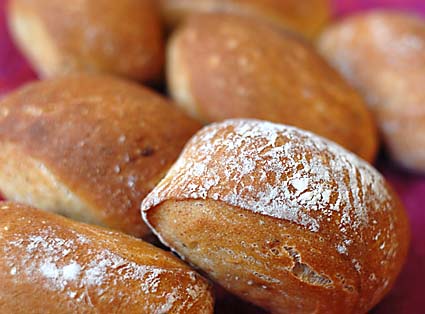
In this post, I’ll go through the method for using a kitchen scale to measure in flour and other ingredients, which some readers, especially outside the U.S., have said they prefer. In this recipe for whole grain baguette buns, I used these weight equivalents for scoop-and-swept cup measures:
1 cup white all-purpose flour: 5 ounces / 140 grams (or 141.7, to be more precise)
1 cup whole wheat flour: 4.5 ounces / 130 grams (127.6)
1 cup water: 8 ounces / 225 grams (226.8)
Most home scales aren’t accurate enough to weigh small quantities of yeast and salt for single recipes.
These whole grain baguette buns are from The New Artisan Bread in Five Minutes a Day, being cut from a baguette-shaped cylinder, which gives the buns crusty little edges that will impress your guests. They’re incredibly easy to make from any of the lean stored doughs that you already have in your fridge, mixed up from our book.
I was in a great restaurant recently, and they served baguette buns, which were delicious but the slightest bit stale. Breads this small go stale fast, and really, the best way to enjoy them is at home, an hour or two after they come out of the oven—and you can even eat these a touch warm and the center won’t seem unready. So here’s how to do it.
First, let’s use some old dough to kick up the sourdough flavor. In the book, we say “never wash the dough bucket,” because that old dough gives sourdough flavor a head start in the next stored batch. You can take that further, by using up to a pound of old dough in the next batch. The problem is getting that sticky dough to incorporate in the water before adding flour. An immersion blender is the best tool I’ve found for that job. I have the Braun MR430HC, but the Cuisinart looks good too. Same for the Kitchen-Aid Immersion Blender. Or just let it sit in the water, and then break it up with a fork.
First measure in some dough. Since I’m going to show you how to use the new-fangled easy-zeroing digital scales to weigh out ingredients, we may as well measure out exactly one pound of dough (I use a Salter Scale, but the Escali is also good). Put your dough bucket on the scale, press the “zero” button, and add dough until it reads 1 pound:

Now, press the zero button again and add water by weighing it. Instead of spooning 3 cups of water (this will be our light whole wheat recipe on page 131 of New Artisan), just weigh the equivalent amount—it’s 24 ounces U.S. (1 pound 8 ounces). Now that the water’s in there, you can use the immersion blender to create a uniform slurry of the old dough, but first, throw in 1 tablespoon of yeast. We test with Red Star Active Dry, Quick-Rise, or Platinum…
… and 1 to 1.5 tablespoons of coarse salt (like kosher salt), based on your taste. Be very careful with the blade end of the immersion blender. Unlike a food processor, there’s no safety interlock to prevent you from touching the blades while they’re running. Don’t let children use an immersion blender:
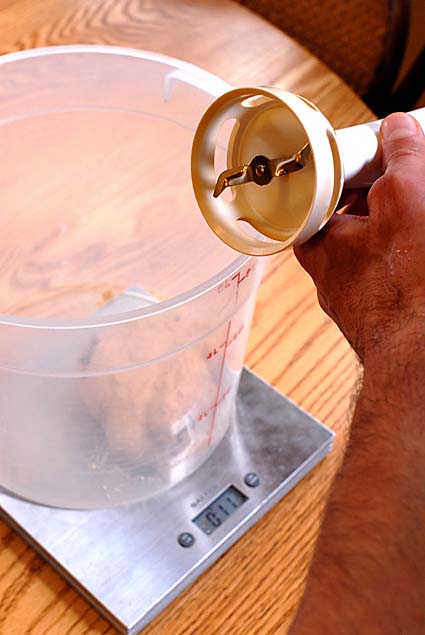
When the coast is clear, let it rip, keeping the head of the immersion blender submerged (or you will get splashed!):
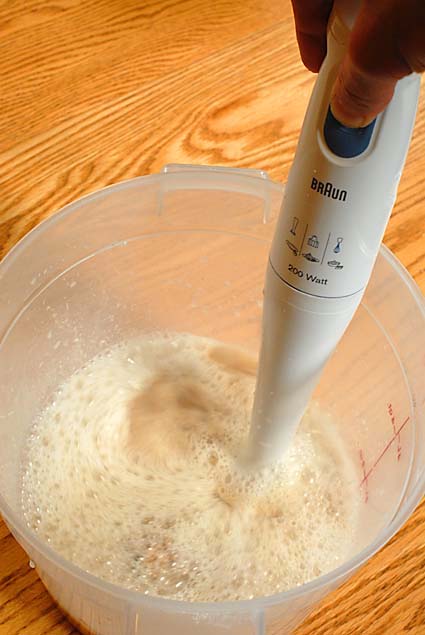
Now put the bucket back on the scale, hit the “zero” button again, and weigh in 2 pounds (32 U.S. ounces) of flour (I used a mixture of all-purpose and whole wheat in a ratio of about 5:1 all-purpose:whole wheat to give the result in the Light Whole Wheat recipe on page 74). If you’re using cup-measures, it’s 5 1/2 cups of white flour and 1 cup of whole wheat. White all-purpose flour weight about 5 ounces per cup, and whole wheat weigh about 4.5 ounces per cup, but at this ratio, it’s very close to 2 pounds total flour (32 ounces). Learn more about mixing our doughs.
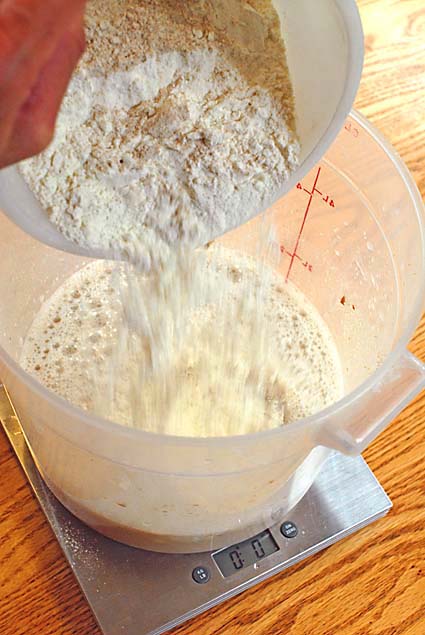
Mix it in with a spoon:
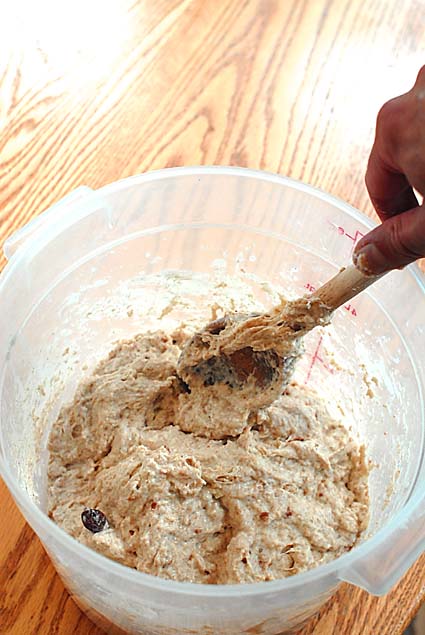
…and the dough is ready after about two hours at room temperature:
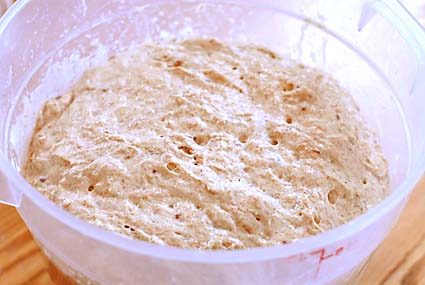
Store the bucket in the fridge for up to two weeks and tear off chunks as you need it (vent the bucket in the first few days by keeping it open a crack). For the whole grain baguette rolls, form a beautiful baguette using the letter-fold technique (see Zoe’s earlier post on this). Then, using a dough scraper or a knife, make angled parallel cuts about 2 inches apart along the length of the baguette:
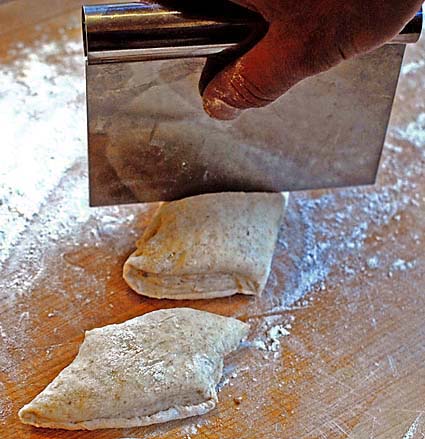
The buns will flatten from being cut, and they won’t appear to rise much before baking, but they get great oven “spring” (like all of our no-knead stored-dough recipes). Let the buns rest on parchment paper or a silicone pad for 20 to 40 minutes:
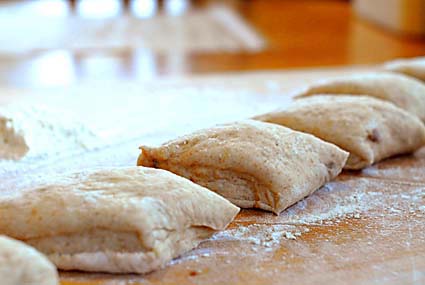
Preheat a baking stone to 450 degrees Fahrenheit (230 degrees Celsius) near the middle of the oven for 20 to 30 minutes, with a broiler tray to catch water on any other shelf that won’t interfere with the buns. Place the parchment or the silicone pad with the buns onto the stone, throw a cup of water into the broiler tray, and bake for about 20 to 25 minutes. You’ll get a gorgeous result, crusty and fragrant:

Wait at least an hour before breaking into them! Any sooner and the texture can be overly moist. Two hours is about perfect.

Note: Red Star Yeast (Lesaffre Corp) sponsored this post, and supplied yeast for recipe testing.
Note: BreadIn5.com is reader supported. When you buy through links on the site, BreadIn5 LLC earns commissions.
Nina: Yes, try some vital wheat gluten… see our post on this at https://artisanbreadinfive.com/?p=142. You can also try the 60% whole grain loaf (more or less) on page 78, but I’m guessing you are looking for more 100% WW approaches. Our next book (out in 12/09 will be all about boosting the whole grains and including other healthy ingredients, fruits, and vegetables).
Hey, can you point me to the article on the web in the Oregonian? I haven’t seen it. Jeff
During Midwestern winters, I use my garage or porch as a walk-in fridge. Since that is often cooler than an actual refrigerator, do I need to let the dough rest longer to warm up more? Should I bake it longer or just follow the recipes?
Thanks! Love the book, by the way.
Hi Barbara,
You will probably need to let the dough rest quite a bit longer before baking. It should no longer feel as though it is chilled when it goes in the oven. Once it has warmed to this point it is not necessary to increase the baking time, unless you are making larger loaves than we specify!
Enjoy the bread! Zoë
Thanks for the fast feedback. I have another question: when you say “Twenty minutes before baking, preheat the over to 450º . . .” do you mean to turn the oven on at that point or to let it heat for 20 minutes after it reaches 450º? Many bread recipes want you to let the oven get really hot before putting the bread in.
Hi Barbara,
For most ovens only 20 minutes is required to heat up the stone to the point where you can put in your bread. Having said that, you may prefer the crust if you allow your stone to heat up just a little more. So 20 minutes is really the minimum amount of time and I usually let mine go closer to 30 minutes.
Hope that helps!
Zoë
I saw your article in Mother Earth News at the library and checked out the site as soon as possible. I can’t wait to try out your breads and get the book. I did have another breakfast option that might work; have you tried using breakfast sausage links for an even better “pigs in blankets?”
Hi Donna, welcome to the site. We haven’t tried “pigs in blankets” but readers have told me it works beautifully. Book’s most easily available (sale price right now) from Amazon: https://www.amazon.com/gp/product/0312362919?ie=UTF8&tag=arbrinfimiada-20&linkCode=as2&camp=1789&creative=9325&creativeASIN=0312362919
Hi!
I stumbled across this recipe while searching for “Baguettes”. Really love the photos and want to bake them! I just wonder: What do you mean by saying “old dough”? Does this have something to do with your book and I will not have a chance to make them until I buy it? I am German, living in Portugal… that already makes the conversion of measurements quite interesting 😉
Hope you can give me a hint on how to prepare these delicious buns without “old dough”. Thanks a lot.
You don’t have to use “old dough,” which we talk about in the book (to purchase from Amazon US, https://tinyurl.com/4as4qd). Taking a piece of dough from the last batch and incorporating it deepens the flavor, but isn’t absolutely neccesary. Jeff
Do you have a recipe for an organic multi-grain loaf which would include flaxseed?
The recipes don’t change for organice ingredients; they measure the same. We do have multi-grain loaves that use flax, but we’re saving them for our follow-up book, Healthy Artisan Bread in Five Minutes a Day, due out in December. Jeff
Wonderful! I’ll look forward to the new book.
We have friends coming this w/e and I plan to cook a beef brisket & shred it for sandwiches for lunch. Which bread recipe would make good rolls/buns for the beef?
Thanks!
Hi Barbara,
Do you want something soft or crusty?
If you want a softer roll I would make them out of the Challah or Brioche dough.
If you want them crusty then you can use the master, peasant or even the rye.
Have fun and enjoy the Brisket sandwiches!
Zoë
Zoe–Thanks for the advice. I decided to go w/ the Challah. My next questions: How many buns from a pound, 4 or 6? And how long do I let them bake? I assume I use the same temp etc.
Thanks!
Hi Barbara,
I would say 4-6 buns from a pound of dough would make them a great size for sandwiches.
Enjoy! Zoë
Quick question- I know you say to leave the dough out for about two hours, then refrigerate it after that. Is it possible to leave the dough out in room temperature for a while longer to better foster a sour taste, or does the wet dough not appreciate this? If it is possible, how long can I afford to keep it at room temperature before I place it back in the fridge? Thanks, your recipes have been amazing so far!
Hi Matt,
I prefer to get this flavor by allowing the dough to ferment slowly over the course of a couple of days in the refrigerator. I also usually save a bit of dough from one “old” batch to add to a fresh batch. it jump starts the flavor.
Having said all of this you can leave your dough out overnight without harm to the dough. I’ve done it several times, not always on purpose! 😉 You don’t want to do that with any of the doughs containing eggs or dairy.
Enjoy! Zoë
re: hot dogs
Try Tofu Pups. A lot of folks are repulsed by the Pups’ appearance — dingy gray with dark flecks — but that’s because they contain nothing unnecessary like food coloring. They are DELISH!
If you can’t get past their looks, there are a million flavors and brands of marinated tofu as another alternative. It’s easy to cut fingers and use them instead of dogs.
Greetings,
Is there a rule of thumb or a table that I have missed that lists weight of dough vs. baking time for say, 375F & 450F?
Thanks, Bob
Hi Bob,
All of the rise times and baking times/temperatures depend entirely on the ingredients that are in the various doughs. It would be hard to make a general chart. Is there a particular bread that you need to adjust?
Thanks! Zoë
Hi Zoë,
Thanks for the quick reply. I was wondering about the master recipe from ABin5
Thanks a million for the books, I eat homemade bread at least 4 days a week now…
Bob
Bob: It’s more complicated than that, because shape makes a big difference. In general, the Master from AB5 is baked at 450. If you keep the shape constant (a high boule), then it’s:
1 lb: 30 min
2 lb: 35 to 45 min
3 lb: 45 to 1 hour
But a lot will depend on characteristics of your oven and your stone. Some setups won’t have such a steep increase. You can also use an instant-read thermometer; the internal temp needs to get to 205 to prevent gumminess.
Also use an oven thermometer for the air temp in the oven. Jeff
I just got a kitchen scale, and I was excited to use it for the master recipe from HB5. It worked really well.
However, I also wanted to be able to mix up some other recipes, and I was disappointed that the conversion chart on page 36 leaves off a lot of ingredients. For example, to make the maple oat bread from page 145, I don’t have measurements for oats, wheat germ, cinnamon, buttermilk, or maple syrup. The cinnamon is no big deal, but the others are important omissions.
Are there any plans to put a more complete chart on the web site and/or in future books? It would be great if all of the recipes had volumetric and weight measurements side-by-side as in the master recipe.
Thanks.
Hi Andrew,
We tried to give the weights for the most common ingredients in the book, but there are clearly more we could have done. It is encouraging how many people are baking by weight, which we agree is the way to go. We will try to create a more comprehensive list at some time.
Thank you! Zoë
Zoe, thanks for your response. I guess there is a something of a chicken-and-egg problem. Hopefully, as more people weigh ingredients, it will become more common for recipes in general to include weights. Thanks for encouraging me (through your book) to try it out.
Hi Zoe
I have written to you twice but no reply !
I have both your books and I’m used to weighing my ingredient as I’m not too good at scooping and measuring by cup.
Here’s the problem that I have encountered –
The measuring cup for wet & dry are different and from US or Australia – again different. When I use the measuring cup for flour for the water, the dough is very very dry. If I use the “wet” measuring cup, the dough is very very wet.
I used the measurement for weighing given in “Healthy bread” for the master recipe in “Artisan bread”
The weight for flour is 910gm and that equate out to be more than 6 1/2 cups. Same for the water. If measured by cups it’s lesser than the weighing machine.
Please help ! What should be the correct measurement ?!
Look forward to hearing from you.
Chris
Christine: I’m a bit confused. Are you hoping to weigh all ingredients for the basic white-dough recipe? Sounds like you have a good scale, and that is the most accurate way. Use 900 grams of unbleached all-purpose flour, and 675 grams of water and the ratio will be exactly what we intended. It’s not a requirement that you use cup-measures, which introduce uncertainty when people in different countries try our recipe.
The result should look like what you see in our videos on this website. Jeff
Zoe & Jeff,
It’s good to hear you have another book coming out. It’s fun to get excited over a new technique, especially with such great results!
I had a suggestion for you, borne out of necessity. Since I don’t have a stand mixer or high capacity food processor capable of mixing the dough (and I guess I didn’t want to take the time to do this by hand) I split the recipe in half (actually in quarters as I had doubled the recipe) and put those batches through my smaller food processor. There was still minimal mess, a liquid measuring cup that held all the liquid and my food processor. I would put the flour in first, add the liquid for that amount of flour, then after it was mixed together I put it in the large plastic bucket. I did not clean the food processor after each batch, and the dough would be added one on top of the other in the bucket. I didn’t mix the batches together and I’ve been very pleased with the resulting breads. I did the same process with the brioche dough (only I didn’t double the recipe) and again, the results have been wonderful.
Can you foresee any problems with this method?
Denise
Denise: No problem with this, should work beautifully. I do something similar when I don’t feel like mixing or am in someone’s place and they don’t have a big spoon (but do have a food processor). Jeff
I would like to get same loaf pan 9 Inch x 4 Inch like you have.
Could you please let me know where you got it?
Thanks.
Lejing: They’re widely available, including on Amazon.com at: https://www.amazon.com/Chicago-Metallic-Professional-Nonstick-1-Pound/dp/B00004R91A?&camp=212361&linkCode=wey&tag=arbrinfimiada-20&creative=380725
Thank Jeff.
I love my Polder scale with its “easy zeroing” feature and huge number display. I don’t know how I ever cooked without it. No more guessing!
Gina: Weighing became much more practical once the zeroing feature became standard with digital scales. Mechanical scales required tedious arithmetic and that scared people off I think.
Today I baked some of the whole wheat bread from the latest book and it never did the oven spring rise so I had flat misshapen loaves. I used KAF white whole wheat instead of standard whole wheat flour. I’ve had great sucess using KAF white ap flour, so I don’t understand why my boules didn’t come out of the oven nice and round. It sort of looks like there isn’t enough flour so the loaves spread out. I’m a long time bread baker and I love this method of bread making.
Holly: Definitely sounds like your dough was too wet, and I’m not at all sure why this would be. I’ve found that WWW swaps one for one with traditional WW. In any case… Just add more flour and you should be fine, you’ll have to work it in. If it persists with this flour, you’ll need to use about 1/4 cup more in the first place (that’s just a guess). Jeff
I try to weigh my ingredients. I used KA White Whole Wheat flour. The bag says 120 grams per cup. I see that you refer to 130 grams. My dough was too sticky – the bread did not rise. Should I use 130 instead –even though the bag says 120?ingredients
Hi Bob,
Our weights are based on the scoop and sweep method, so a cup of flour in our recipes weighs more than some others that you will find. You need to use the 130g or the recipes will come out too wet.
Thanks! Zoë
I’m so confused on what to believe. Every where I look on the internet the weight of one cup of flour varies from source to source. I watch America’s Test Kitchen and they suggest King Arthur Unbleached All Purpose Flour. They use the Dip and sweep yielding 5 ounce [142 gram] cups of flour, but King Arthur says “Lightly” spoon and sweep yielding 4.25 ounce [120 gram] cups of flour. Most commonly used by King Arthur in their web recipes and books, they also list weights parenthetically to help get the correct quantity of flour.
Why are there two different methods? For accuracy how do you know which one is correct and will .75 ounces of flour make a difference in my baking. Also if I’m not using a recipe that says the amount of flour in ounces or grams which one do I use 4.25 ounces or 5 ounces?
Im also confused on the amount of protein, I know you want high protein flour like King Arthur in bread, but should I use a less protein flour for cakes and such if I want them to be tender? Whats the rule when it comes to protein content in recipes?
Jessica: It’s all in our books, in the “Ingredients” chapter… We use the scoop and sweep, which gives you about a 5 ounce cup of unbleached AP, maybe a hair less. Spoon and sweep is much lighter, and we don’t use it. See my video for how we measured for our book: https://artisanbreadinfive.com/?p=1801
I just made the Light Whole Wheat bread recipe, which says I should get three 1.5 lb loaves. However, I ended up with only about 3.25 lbs of dough total. Did I do something wrong? The difference in yield wouldn’t be an issue, except that I’m trying to calculate nutritional info. Also, I noticed that when I went to bake that second loaf after leaving the dough in the fridge for a couple of days, the top of the dough was a bit dry, and as I shaped it into a ball it seemed a bit lumpy, like there were drier spots throughout. I measured the ingredients exactly, and I left it in a covered plastic container in the fridge with the lid slightly off. Thanks!
Corinne: You experienced some drying of the surface, which generally doesn’t harm anything unless it gets really hard. You can snap down the plastic lid after 48 hours and this usually prevents the problem.
Our first book tends to yield less than 4 full one-pound loaves, you’re getting 0.8-pounders (I usually get 0.9 pounders from that recipe…
So it isn’t you! Jeff
Correction: The recipe says it makes four 1 lb. loaves. I still didn’t get enough dough though.
Hi Corinne,
Thank you, the recipe makes about 3# 12-ounces of dough which results in 4 loaves that are just shy of 1-pound. If you want larger loaves or more of them you can always double the recipe.
Thanks, Zoë
Thanks so much for the response. 🙂 I’ve got to say that your first book is hands down the best cookbook I’ve ever purchased (and I’ve got a HUGE shelf full of them). I say this because it’s had the most impact on how I live and eat. I haven’t bought bread in the past 2 weeks, because making fresh bread using your recipes is so simple and it tastes so good. My husband and I go through a loaf every couple of days, and when the bread’s been in the oven for about 20 minutes, he starts sniffing around the oven and pacing the kitchen. I have to keep a close eye on him while it cools so he doesn’t steal any! Thanks for making bread making accessible for busy people like us!
Thanks for the kind words Corinne, come back anytime w/questions. Jeff
Hi,
I’m actually new at baking bread, but when I saw your recipe I couldn’t wait to try it. Unfortunately, it didn’t work out as expected… When I tried to shape a loaf, I found the dough to be incredibly sticky and moist and I could just -not- form a decent loaf with it. I ended up hurling the first attempt away in complete frustration, after wrestling with it quite a while. Then I added a decent amount of extra flour to it, trying not to knead it, and this worked out fairly well and eventually I got a decent bread, yet the loaves were still a pain to shape. I realized I must’ve made a mistake converting the quantities, so I snooped around in the FAQ section and found this thread and decided to try it again. My third attempt however (let’s not talk about me overheating the water in my second attempt), is proving to be not that less moist then my first try, but I did manage to shape a decent loaf without losing my temper. Clearly, I must be doing something wrong. Could you please help me out? Because I really, really want to master this recipe, as I am in desperate need of firm, crunchy bread now that I am currently residing in Turkey for a while and really miss Belgian bread!
Thanks! Amina
Hi Amina,
I wonder if the flour you are getting in Turkey is different than the ones we use here and this could be the source of some of your issues? What kind of flour are you using? Any idea what the protein content is?
It may also just be that you are not using enough flour when shaping the loaf? Here is a video of how to shape a loaf with very wet dough. https://artisanbreadinfive.com/?p=1715
I just returned from Istanbul and long to be back there! Enjoy, Zoë
Is the Whole Wheat Brioche dough generally hard to work with? Mine raised so much it overflowed the bowl before refrigerating, was so wet I had a hard time shaping it (even after chilling for 4 hours), and again nearly overflowed the loaf pan before going in the oven. (I used it in the Apple Strudel Bread on p. 278–HBin5). Is this typical for this recipe? I haven’t had any trouble with the other doughs I’ve tried.
Hi Sarah,
If your dough was very warm when it went into the refrigerator it may have needed more than 4 hours to fully chill. If so, the resting times on the bread may have needed to be shorter. Did the bread rise at all in the oven?
If the dough isn’t any easier to handle after resting in the refrigerator overnight then maybe there isn’t enough flour in the dough. When I have missed a cup of flour I get a similar result. You can always add a bit more flour, let it rest to absorb the excess water and try it again.
Hope this helps, Zoë
I am trying the gluten-free recipes in the book. However, could you post the weight measurements for the gluten-free flours? Especially starches has a tendency to get very compact and I think it is easier and better to weigh the ingredients. Thanks.
Marie: At the moment, we do not have weight equivalents for the gluten-free flours, but will post them when available. Unfortunately we have book deadline coming up, and I can’t say when this is going to happen. Jeff
Measuring flour is subject to density variation but water is not (thermal effects are minimal for household temperatures). A cup of water is 236 grams not 225 as you give above.
Matt: Agree that there’s no point in temperature/density correction. But…
Have you weighed a typical household cup-measure (like Pyrex liquid measuring cups), using a typical household ounce/gram scale like this one on Amazon: https://amzn.to/cvBlHe? We get very close to 8 ounces (US weight), which is very close to 226 grams, we round down to 225. Jeff
I admit I took it from a reference without trying it myself. When I used a one cup measure I did see it at 226 grams myself. I decided to try an 8 cup measure and I get 1.863 kg which is 233 grams/cup. I suspect the home scales aren’t that accurate on small values – despite their advertised claims 🙁
Hi,
I was asked to come up with a garlic bread recipe for work, so I started playing woth you MAster Recipe. The first I made it X1 and the loaves came out very nice. Then I increased to X2 (6 3 3 13) as suggested in the book and it still came out ok. However, when I tried x$ (12 6 6 26), the dough becamevery wet and the final result was a dense bread. I need to bake 90-2lb loaves, any suggestion on how to increase the quantity without getting into this problem?
thanks,
Alex
Hi Alex,
What are you mixing the dough in for a batch that size? Your best bet is to do this by weights, the use of cups at that scale is unpredictable.
1 cup = 5 ounces unbleached all-purpose flour
6 1/2 cups = 2 pounds flour
4 x batch would be 8 pounds flour and so on.
Hope this helps and good luck, Zoë
I tried to make baguettes today and this didn’t work out at all well. Better than a past attempt using traditional kneaded dough, but that’s not saying much since that ended up being long skinny bats that the dog wouldn’t even eat.
I think it might have worked out OK except when I went to put the dough in the oven, the baguettes had soaked through the parchment paper and stuck to it. Fearing having paper baked into my dough, I had to turn them off the paper (leaving some of the dough behind because it would NOT release) and try again. Fearing that it would stick again, I only let it rest a few minutes then popped them in the oven, heart in throat.
They did rise considerably in the oven but still ended up being a pretty sorry looking excuse for baguettes.
What can I do to improve the situation?
Sojourner: Assuming you’re using a silicone-coated paper, this wouldn’t have stuck if you’d left it where it was. You just slide the whole thing, paper and all, onto the baking stone or other surface in the oven. It peels off when baked, ideally about 2/3’s through baking to let the bottom crisp and dry out.
But no, the paper won’t release from unbaked dough…
Jeff
Since it’s so much easier to weigh rather than measure 6 cups of flour; I switched to weighing and it was a disaster. On doing research: the first thing I discovered is that 5 oz of unbleached AP flour on my scale was about 1/4 cup more than 1 cup. And other books list different weights for 1 cup of flour. The bag of flour I’m using says there is about 4.71 oz of flour per cup. For the moment, I’m back to measuring with a cup (with great success). Yes, I use the scoop and sweep method. What is going on? Why the variation?
Hi Christina,
Which recipe are you making? Did you mix the dough using the 5 ounce measure for flour, and that didn’t work for you? I’m surprised, since this is how I always make my dough. Are you using a flour that is particularly high in protein, like King Arthur flour? If so, it will result in a much drier dough.
When you scoop and sweep the flour how much is your cup of flour weighing? Be sure not to aerate before scooping.
Glad the dough is coming out well when using the measuring cup, but we should work out the weights so it will be easier for you! Thanks! Zoë
Hi Zoë, i have a question on measuring cup.
I normally use a set of cups with 1 cup equals 240ml.
So 1 cup will give 240ml water.
But as in your entry, 1 cup water = 225g. So i suppose 1 cup of yours is 225 ml?
Hi Fiona,
Jeff was weighing the water and it was 225 grams, which equals 1 cup or 240 ml when measured! So all of it is correct!
Thanks, Zoë
Hi Jeff and Zoe,
In Challah recipe, is honey measured in liquid measurement cup or non-liquid measurement cup (e.g. cups to measure flour)?
Thanks,
Miho
Miho: Confused– which recipe are you using (which book/page number)?
Thank you Zoe!! I’m in love with all of your recipes. My fav is the Light Whole Wheat, i make it every week for pizza, baguette, boule….Delicious. Now i feel like having something with more whole wheat, but less dense than the 100% whole wheat loaf. Can I increase the amount of whole wheat flour (say, one and a half or two cups) in the light whole wheat dough and reduce the AP flour correspondingly? Any other adjustment needed? More or less water, yeast? thanks!!
Fiona: Yeast would stay the same, but you’ll probably need a little more water. 1/8 cup? 1/4 cup?
Jeff
Sorry to take so long to respond. It’s been several recipes that I’ve had this problem (see my request for help on Sep 28) –and it wasn’t until I weighed just 5 oz of flour and thought it looked like too much (it was 1 1/4 cups) that I realized the problem. Since then, I weighed one cup from the same bag of flour and it weighed 5.25 oz. I think I need a new scale.
By the way, for people looking for scales–try to find one that uses more common batteries rather than those expensive round things.
Thanks Jeff for your very quick answer. I made my experiment today, increasing whole wheat flour to 2 cup per batch, and add 2 tsp of water. My bread took longer to bake, but tasted just great. Love it.
Now I want to take one step further, with adding oatmeal or wheat germ to the bread. Any suggestions? Thanks a lot !!
Hi Jeff,
Thank you for your quick response.
I have a question regarding Challah recipe in page 180 of Artisan Bread Five Miutes a Day. 1/2 cup of honey is called for the recipe. How do you measure it, by using liquid measuring cup like Pyrex or non-liuqid measuring cup which you use to measure flour? If it does not matter, then could you please provide how much honey needed in gram or ml or cc?
Thank you,
Miho
Miho: Liquids can be measured in either, but powders can really only be measured in a non-liquid measuring cup, becuase you need to level them off to measure accurately. But weight is a good way to do it too– that’s in a table in our second book, Healthy Bread in Five Minutes a Day (https://bit.ly/3wYSSN ). Not able to reprint that table here, publisher would kill us!
Jeff
Fiona: At some point, you’ll cross a threshold where you’ll need vital wheat gluten, or the stuff will be too dense to store. Here are some guidelines for using that stuff: https://artisanbreadinfive.com/?p=142
What you’re considering are all kind of heavy ingredients. See what you think. Jeff